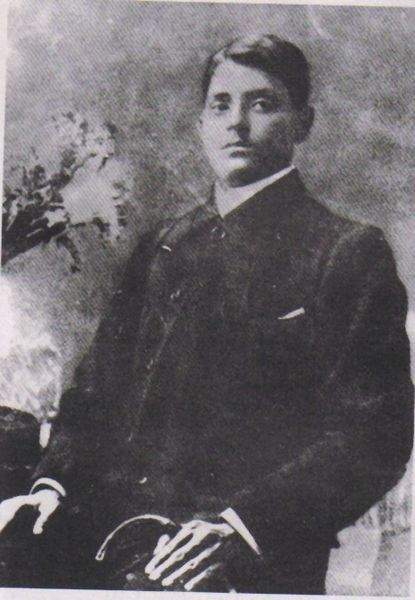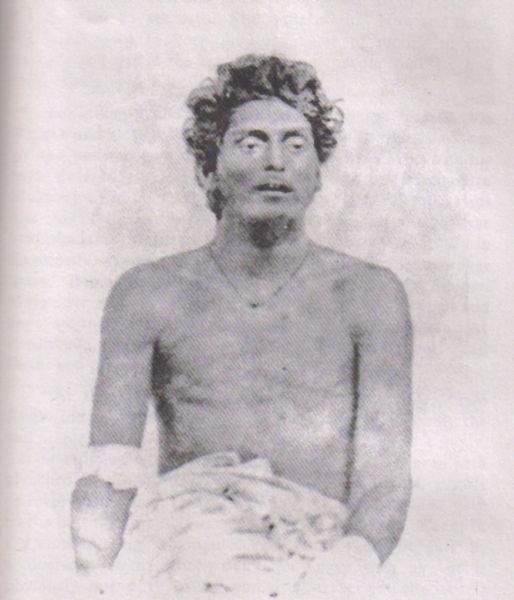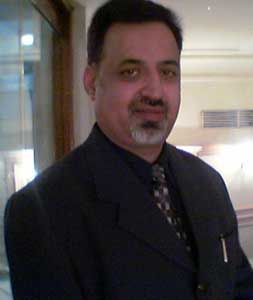| Bagha Jatin Mukherjee(1879-1915) revolutionary activist. Bagha Jatin's
real name was Jatindra Nath Banerjee. He hailed from Jhenaidha district.
It is said that he came to be called 'Bagha Jatin' after killing a tiger
single-handed and without any arms. He learnt short hand and type writing
after passing the Entrance Examination and was appointed a stenographer
to the government of Bengal. Jatin, a strong and stout young man, proved
his efficiency as a sincere, honest, obedient and diligent employee.
Jatin, a man with a strong sense of self-respect and national pride,
came in contact with aurobindo ghosh, and took part in climbing, swimming
and shooting in the body building Akhda. While working for the Yugantar,
he met Naren (manabendra nath roy) and the two soon gained the confidence
of one another. In 1908 Jatin, with some revolutionaries, was implicated
in the Alipore Conspiracy Case. In the judgement Barin Ghosh was deported
for life, many others were sentenced to various terms and the anushilan
samiti was declared illegal and banned. Jatin and Naren, acquitted for
want of evidence, went in hiding to Hawra-Shibpur area and continued underground
works with other revolutionaries.
Jatin was once again arrested in the Hawra-Shibpur Conspiracy Case,
and those who were arrested with him were given the common name 'Jatin's
gang'. They were so ruthlessly tortured that some of them died and some
went insane. Jatin, though acquitted in this case also for want of evidence,
was dismissed from service. When in jail, Jatin and Naren made a long term
programme to capture power through armed insurrection. They planned to
unite different groups of patriots and with this intention Naren travelled
extensively all over India as a Sanyasi and organised the revolutionaries
in Bengal and elsewhere. The leaders of various groups gathered together
on the occasion of relief works during the floods in Hughli and Midnapore.
They chose Jatin Mukherjee and Rashbehari Bose as leaders for Bengal and
northern India respectively.
Attempts were made to organise the Indian revolutionaries outside India
also. A Yugantar Ashram was formed at San Francisco and the Shikh community
took active part in the struggle for freedom. With the outbreak of the
First World War, the Indian revolutionaries of Europe gathered together
in Berlin to form the Indian Independence Party and sought German assistance,
to which the German government agreed. The Indian Independence Party sent
an emissary to Jatin Mukherjee to negotiate with the German Consul General
in Calcutta. In the meantime Jatin was made the Commander-in-Chief of the
entire revolutionary forces. Naren, leaving Jatin in hiding in Baleswar
(Orissa), went to Batavia to negotiate a deal with German authorities there
for the shipment of arms and financial help.
Police, however, discovered the hideout of Jatin in a paddy field. On
9 September 1915, after heavy exchange of fire, two revolutionaries surrendered.
Police found Jatin dead with two others injured. Of the two injured one
died later and was identified as Chitta Priya Roy Choudhury of Madaripur.

Jatin was born in Kayagram, a village in the Kushtia subdivision of Nadia
district in what is now Bangladesh. His parents were Umeshchandra Mukherjee
and Sharatshashi; he grew up in his ancestral home at Jhenaidah till his
father's death when Jatin was five years old. His mother settled in her
parents' home in Kayagram with him and his elder sister Benodebala. As
he grew older, Jatin gained a reputation for physical bravery and great
strength; charitable and cheerful by temperament, he was fond of enacting
mythological plays and playing the roles of god-loving characters like
Prahlad, Dhruva, Hanuman, Râja Harish Chandra.[1] The name by which
he came to be known ("Bagha Jatin" [variously spelt "Jotin", "Jyotin",
and "Jatin" — Tiger Jatin) derived from an incident in which he killed
a tiger with nothing but a Darjeeling dagger. The then leading surgeon
of Kolkata, Dr Suresh Prasad Sarbadhikari who operated upon Jatin, "took
upon himself the responsibility for curing that fatally wounded patient
coming twice to his house daily to dress his wounds personally..."
After passing the Entrance examination in 1895, Jatin joined the Calcutta
Central College (now Khudiram Bose College), for his First Arts. Soon he
started visiting Swami Vivekananda, whose social thought, and especially
his vision of a politically independent India, had a great influence on
Jatin. As a mission from the monk, he raised a batch of volunteers to serve
the miserable compatriots during famines, epidemics and floods, and running
clubs for "man-making" in the context of a nation under foreign domination.
He often joined Sister Nivedita, the Swami's Irish disciple, in this venture.
In 1899, while working as the Barrister Kennedy's secretary at Muzaffarpur,
Jatin realised how urgent it was to have an Indian National Army and to
react against the British squandering Indian budget to safeguard their
interests in China and elsewhere. In this context one can better appraise
why Jatin's exemplary heroism inspired Dr Sarbadhikari's organisation of
the Bengal Regiment sent to the Mesopotamian battle-field in 1916.
In 1900, Jatin married Indubala Banerjee of Kumarkhali upazila in Kushtia;
they had four children: Atindra (1903–1906), Ashalata (1907–1976), Tejendra
(1909–1989), and Birendra (1913–1991).
Jatin was alerted and advised to leave his hiding place, but his insistence
on taking Niren and Jatish with him delayed his departure by a few hours,
by which time a large force of police, headed by top European officers
from Calcutta and Balasore, reinforced by the army unit from Chandbali
in Mayurbhanj State, had reached the neighbourhood. Jatin and his companions
walked through the forests and hills of Mayurbhanj, and after two days
reached Balasore Railway Station.
The police had announced a reward for the capture of five fleeing "bandits",
so the local villagers were also in pursuit. With occasional skirmishes,
the revolutionaries, running through jungles and marshy land in torrential
rain, finally took up position on September 9, 1915 in an improvised trench
in undergrowth on a hillock at Chashakhand in Balasore. Chittapriya and
his companions asked Jatin to leave and go to safety while they guarded
the rear. Jatin refused to leave them, however.
The contingent of Government forces approached them in a pincers movement.
A gunfight ensued, lasting seventy-five minutes, between the five revolutionaries
armed with Mauser pistols and a large number of police and army armed with
modern rifles. It ended with an unrecorded number of casualties on the
Government side; on the revolutionary side, Chittapriya Ray Chaudhuri died,
Jatin and Jatish were seriously wounded, and Manoranjan Sengupta and Niren
were captured after their ammunition ran out. Jatin died in Balasore hospital
on 10 September 1915.

Bagha Jatin Mukherjee after the final battle. Balasore, 1915.
|







